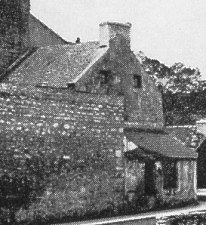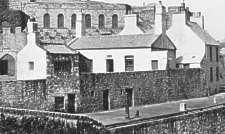demolished by the mid-seventeenth century, thus creating the space
which is now Parliament Square.12 Bishop Wilson's Library, on the site
of the Old House of Keys, and The High Bailiffs House, were built at
about the same time in the 1720s. The dates of the other buildings,
which make up the square today, are uncertain, but they were in place
by the 1841 Census, where the name is recorded as St. Ann's Square.
occupied by the Schofield family. Thomas, who was a
joiner, had his shop in a loft at Bay View, to which he had
access by a ladder from the street. The local College boys
when passing would pull the ladder away so he could not
get down until someone passing would put it right for him.
He afterwards locked it to the door frame, but that did not
help him much as they pulled it away at the bottom and let
it sling by the chain. James, who had been working in
England, came back when he retired; Robert, who was a
joiner, lived and worked at College Green until he came
here to live; and their two sisters.
Westminster Bank in the Old House of Keys. When Robert Schofield
died in 1914 he was, at the age of ninety, Castletown's oldest inhabitant.
Much respected, he was a member of Castletown Poor Relief Society
and Director of both the Gas and Water Works Companies and an
esteemed member of the Athol Club.
on Dumbell's Bank when it went smash. We did not deal
with this bank, but several who did paid us with cheques on
it, but we had cashed them. It then became Parr's Bank and
is now the Westminster.
built by Bishop Wilson in about 1720. The Keys used the ground floor
for their meetings. This was replaced in about 1820 by the present,
slightly larger, building on the same site. The architect was Thomas
Brine. The meeting chamber for the Keys was on the ground floor while
the keeper, Edward Colquitt, and his large family, lived on the floor
above. The building was further altered and refurbished in the 1860s,
but already in 1874 the Keys no longer wanted to meet there because of
its poor condition. It was taken over by Dumbell's Bank, and when it
failed in 1900, it became Parrs Bank and from 1918 Westminster Bank.
In 1973, the building was presented to the Castletown Commissioners
on condition that it would be used to serve the town. It became the
Town Hall until the Town Hall and Civic Centre on Farrant's Way opened
in 1989. The old House of Keys was then acquired by Manx National
Heritage. They restored the fabric and there is a display, open to the
public. 13
Taggart for housing his traps.
horse all decked out in black ribbons. The driver, also dressed in black
with a top Shiner [hat], was a Mr. Corkill. It used to amaze him how a
small man could control such a large shining animal. The shed has
recently been enlarged with an upper storey.
Robert Kewley who has a grocer's shop in it. It was
afterwards occupied by the Misses Callow, dressmakers,
who built a workroom between it and the shed.
Merchant and Provision Dealer, father of Archdeacon Kewley, was the
tenant here until 1895, when it was sold to the Misses Callow. In 1950
the property was sold to Miss Annie Hill and given its current name. The
workroom was until recently in use by Mrs. Ruby Clarkson, soft
furnishings.
kept by a Mr. Richard Watterson. It was converted into a
restaurant by Mr. John Cannell whose wife took in
boarders. The Oddfellows Club had a mortgage on it and
Mr Cannell's son, Charles, chucked it up to them too soon,
and the Post Office rented it soon after.
offices, with access from Parliament Square, was completed and named
Harbour Mews. At that time the history of the building, known since the
late nineteenth century as Derby House, was explored. The date of the
present building on the site is not known for certain, but Robert and John
Duff, Tobacco Manufacturers and Wine and Spirit Merchants, built the
warehouse and stabling in the mid-nineteenth century, and it is likely
that this would have included the main building as well. Richard
Watterson, draper, and family were in the building from the 1880s and
Cooper's memory is, as always, accurate when he tells of what followed.
The Post Office moved out in 1997 and the building is now divided into
two offices. Until recently Simcocks, Advocates, occupied the premises
facing the Square.
There was an old house against the gable which was
occupied by Mr. Cannell's daughter and son-in-law, Mr.
Grattan, but this was pulled down to build the present
police Station, which was built by my father, the architect
being Mr. Baillie-Scott.

Old house on site of Baillie-Scott Police Station c.1900
Castletown Police Station was the last building in the Isle of Man
designed by Baillie Scott (1865-1945). It was completed in 1901. The
building is a fine example of the Art Nouveau style. For typical designs in
the style - note the iron straps on the doors. The use of the doors was
changed in the spring of 2000, the entrance now being from the Quay.

The Quay looking from footbridge c.1900
tenant I remember was a Mrs. Moore and afterwards her
sister Mrs. Sayle. Her son, Eddie, served his time with my
father as a joiner and later emigrated to Canada. He came
back and joined the navy in the First World War. He now
lives in the Crofts.
appears in many early representations alongside the Castle. In 1987, it
was closed down amid an outcry from its devoted regulars. A petition of
2,000 signatures was sent to the brewery to no avail. However, at the
beginning of the 1990s, Stewart Jamieson reopened it completely
refurbished.14
quarters when the soldiers were stationed here. The inside
one is now the Custom House and the other the garage and
Weights and Measures Office. The space outside the
Custom House was called the Quarter Deck because sailors
and others were in the habit of walking back and forward at
the low wall between the Custom House and a small
building now pulled down where a Custom House Officer
was on duty during tide times. There was a flag staff at this
building and an iron standard on which they hung scales to
weigh customed goods. There was a cellar under it with a
door from the Quay, now filled up.
Office.